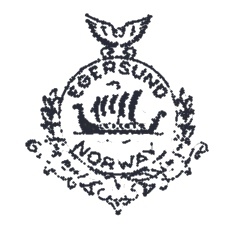Egersund Fayanse was founded in 1847 under the name Egersunds Potteri by Johan Feyer who himself was a pottery maker, trained in Newcastle upon Tyne. Feyer brought English pottery makers to Egersund to teach the craft to local workers. For the first 20 years, the factory produced the brown pottery that this region is known for made from local clay. In 1851 the factory had 26 employees.
In 1863 Feyer started the transformation process to start producing white pottery, the so-called fajanse, and the factory was renamed Egersunds Fayancefabrik. They hired Swedish pottery makers from Rörstrand and English labourers. The faience was produced out of a mixture of clay, kaolin, Danish flint and Norwegian quartz. The first years, pottery with a simple decor were made, often transfer prints, inspired by other makers, magazines and so on. Eventually, the company developed a strong artistic profile, and were associated with artists like Kitty Kielland, Jacob Sømme (who designed one of their most iconic products, the Puffin jug), Oluf Wold-Torne, Andreas Schneider, Andreas Ollestad, Jacob Bjorheim and Theodor Friestad. Alongside everyday household products, they also made more prestigious pieces, like enormous vases for exhibitions.
The factory burned down in 1905, but was rebuilt in 1907 with bigger capacity and electrical power. It expanded profoundly in 1950 to meet the demands of the post-war years, and the work force were close to 500. The harsh demands of mass production eventually forced them to join forces with other companies. In 1967, the factory merged with Porsgrunds Porselænsfabrik, from 1975-77 they were owned by Arabia and from 1978 by Upsala-Ekeby, until they were closed down in 1979.







